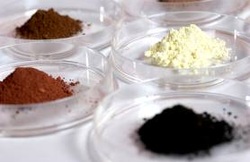
Scientists at the Faculty of Engineering in Leeds have discovered a way to recover major amounts of rare-earth oxides usually found in titanium dioxide minerals. These rare-earth oxides, essential for wind turbine manufacturing and energy-efficient lighting, are cheaply extracted from waste materials of other industrial processes.
If brought to industrial level, the newly discovered process might eventually alter the power balance of supply in the world, breaking the near monopoly of China on these crucial, limited resources. China presently controls 95% of the global reserves of these rare-earth oxides in the global market which caters a steadily increasing demand.
“These materials are also widely used in the engines of cars and electronics, defence and nuclear industries. In fact they cut across so many leading edge technologies, the additional demand for device related applications is set to outstrip supply,” accounted Professor Animesh Jha, head of the study.
“There is a serious risk that technologies that can make a major environmental impact could be held back through lack of the necessary raw materials -- but hopefully our new process, which is itself much 'greener' than current techniques, could make this less likely”.
Regardless of their name, these rare-earth metals appear more frequently in the Earth’s crust as compared to other precious metals; however, their oxides are seldom found in ample concentrations to consider purification and commercial mining. They are, nevertheless, found rather often with titanium dioxide – a mineral used widely from medicines and cosmetics to aerospace industries and electronics, which the professor has been studying for the past eight years.
This new technology not only reduces hazardous wastes and carbon dioxide emissions, but also extracts major amounts of rare-earth metal oxides, as one of the products of its refining method.
If brought to industrial level, the newly discovered process might eventually alter the power balance of supply in the world, breaking the near monopoly of China on these crucial, limited resources. China presently controls 95% of the global reserves of these rare-earth oxides in the global market which caters a steadily increasing demand.
“These materials are also widely used in the engines of cars and electronics, defence and nuclear industries. In fact they cut across so many leading edge technologies, the additional demand for device related applications is set to outstrip supply,” accounted Professor Animesh Jha, head of the study.
“There is a serious risk that technologies that can make a major environmental impact could be held back through lack of the necessary raw materials -- but hopefully our new process, which is itself much 'greener' than current techniques, could make this less likely”.
Regardless of their name, these rare-earth metals appear more frequently in the Earth’s crust as compared to other precious metals; however, their oxides are seldom found in ample concentrations to consider purification and commercial mining. They are, nevertheless, found rather often with titanium dioxide – a mineral used widely from medicines and cosmetics to aerospace industries and electronics, which the professor has been studying for the past eight years.
This new technology not only reduces hazardous wastes and carbon dioxide emissions, but also extracts major amounts of rare-earth metal oxides, as one of the products of its refining method.
 RSS Feed
RSS Feed